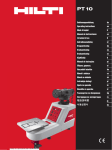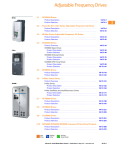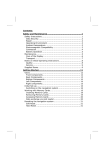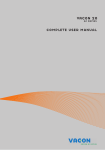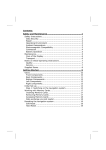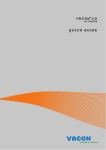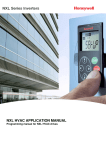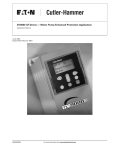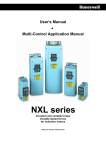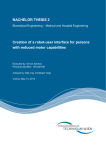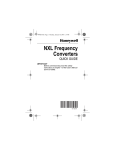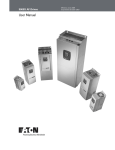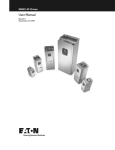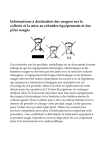Download Quick Start Guide
Transcript
MN04003009E.fm Page 0 Wednesday, November 9, 2011 8:47 AM SVX9000 Drives Quick Start Guide Effective November 2011 Supersedes December 2003 CONTENT STEP 1 — Keypad Operation Overview STEP 2 — Standard Wiring Diagrams and Connections STEP 3 — Start-Up Wizard STEP 4 — Operating and Programming Menu Navigation STEP 5 — Faults and Warning Indication STEP 6 — Monitoring Menu MN04003009E.fm Page 1 Wednesday, November 9, 2011 8:47 AM STEP 1 Keypad Operation Overview Keypad and Display LCD Status Indicators Indicator Description Run Indicates that the SVX9000 is running and controlling the load. Blinks when a stop command has been given but the SVX9000 is still ramping down. Counterclockwise Operation The output phase rotation is BAC, corresponding to counterclockwise rotation of most motors. Clockwise Operation The output phase rotation is ABC, corresponding to clockwise rotation of most motors. Stop Indicates that the SVX9000 is stopped and not controlling the load. Ready Indicates that the SVX9000 is ready to be started. Alarm Indicates that there is one or more active drive alarm(s). Fault Indicates that there is one or more active drive fault(s). I/O Terminal Indicates that the I/O terminals have been chosen for control. Keypad Indicates that the keypad has been chosen for control. Bus/Communications Indicates that the communications bus control has been chosen for control. LED Status Indicators Indicator Description local Local — Steady Illumination Indicates that the SVX9000 is ready to be started and operated from the Local mode. Local — Flashing Indicates that the SVX9000 is ready for operating command to select Local or Remote operation. remote Remote Indicates that the SVX9000 is operating and controlling the load remotely. Remote — Flashing Indicates that the SVX9000 is ready for operating command to select Local or Remote operation. fault Fault Indicates that there is one or more active drive fault(s). 1 SVX9000 Drives MN04003009E—November 2011 www.eaton.com MN04003009E.fm Page 2 Wednesday, November 9, 2011 8:47 AM STEP 1 (Continued) Navigation Buttons Button Description Start This button operates as the START button for normal operation when the “Keypad” is selected as the active control. Enter This button is used in the parameter edit mode to save the parameter setting and move to the next parameter … • to reset the Fault History if pressed while in the “Fault History” menu. • to confirm the acceptance of a change. • to change a virtual button status while in the “Button” menu. • to confirm the start-up list at the end of the Start-Up Wizard. • when the “Operate” menu is active, to exit the “Operate” submenu. Stop This button has two integrated operations. The button operates as STOP button during normal operation … • motor STOP from the keypad, which is always active unless disabled by the “StopButtonActive” parameter. • used to reset the active faults. Reset Resets the active faults. Local / Remote Switches between LOCAL and REMOTE control for start, speed reference and reverse functions. The control locations corresponding to local and remote can be selected within an application. Left Arrow • • • • • navigation button, movement to left. in parameter edit mode, exits mode, backs up one step. cancels edited parameter (exit from a parameter edit mode). When in “Operate” menu will move backward through menu. At end of “Start-Up Wizard”, repeats the “Start-Up Wizard” setup menu. Right Arrow • • • • navigation button, movement to right. enter parameter group mode. enter parameter mode from group mode. When in “Operate” menu will move forward through menu. Up and Down Arrows • move either up or down a menu list to select the desired menu item. • editing a parameter/password, while the active digit/character is scrolled. • increase/decrease the reference value of the selected parameter. • in the “Operate” menu, will cause the display of the active reference source and value and allow its change if the keypad is the active reference source. Used to set the password (if defined) when leaving the “Operate” menu. • scroll through the “Active Faults” menu when the SVX9000 is stopped. Menu Navigation Navigation Tips To navigate within one level of a menu, use the up and down arrows. To move deeper into the menu structure and back out, use the right and left arrows. To edit a parameter, navigate to show that parameter’s value, and press the right arrow button to enter the edit mode. In edit mode, the parameter value will flash. SVX9000 Drives MN04003009E—November 2011 www.eaton.com 2 MN04003009E.fm Page 3 Wednesday, November 9, 2011 8:47 AM STEP 1 (Continued) When in edit mode, the parameter value can be changed by pressing the up or down arrow keys. When in edit mode, pressing the right arrow a second time will allow you to edit the parameter value digit by digit. To confirm the parameter change you must press the ENTER button. The value will not change unless the ENTER button is pushed. Some parameters can not be changed while the SVX9000 is running. The screen will display LOCKED if you attempt to edit these parameters while the drive is running. Stop the drive to edit these parameters. See the SVX9000 Application Manual for identification of these parameters specific to your chosen application. Main Menu The data on the control keypad are arranged in menus and submenus. The first menu level consists of M1 to M8 and is called the Main Menu. The Main Menu is illustrated on Page 7. Some of the submenus will vary for each application choice. STEP 2 Standard Wiring Diagrams and Terminal Locations Power and Motor Wiring Terminal Schematic for SVX9000 Drives Power Board 230V 480V 1 – 15 hp 1-1/2 – 30 hp Control Board L1 L2 L3 B- BR U V W B+ R- T1 T2 T3 BR (Optional) External RFI-Filter (Optional) L1 External Filter (Optional) L2 L3 M 3~ SVX9000 Power and Motor Wiring for Low Horsepower Drives (1 – 30 hp) 3 SVX9000 Drives MN04003009E—November 2011 www.eaton.com MN04003009E.fm Page 4 Wednesday, November 9, 2011 8:47 AM STEP 2 (Continued) Power Board 230V 480V 20 – 30 hp 40 – 250 hp Control Board L1 L2 L3 B- BR U V W B+ R- T1 T2 T3 BR (Optional) External RFI-Filter (Optional) L1 External Filter (Optional) L2 L3 M 3~ SVX9000 Power and Motor Wiring for Large Horsepower Drives (20 – 250 hp) SVX9000 Drives MN04003009E—November 2011 www.eaton.com 4 MN04003009E.fm Page 5 Wednesday, November 9, 2011 8:47 AM STEP 2 (Continued) Standard Application Default I/O Configuration Reference potentiometer 1 – 10 kW mA Terminal Signal Description OPTA1 1 +10Vref Reference output Voltage for potentiometer, etc. 2 AI1+ Analog input, voltage range 0 – 10V DC Voltage input frequency reference 3 AI1- I/O Ground Ground for reference and controls Analog input, current range 0 – 20 mA Current input frequency reference 4 AI2+ 5 AI2- 6 +24V Control voltage output Voltage for switches, etc. max 0.1A 7 GND I/O ground Ground for reference and controls 8 DIN1 Start forward (programmable) Contact closed = start forward 9 DIN2 Start reverse (programmable) Contact closed = start reverse 10 DIN3 External fault input (programmable) Contact open = no fault Contact closed = fault 11 CMA Common for DIN1 Connect to GND or +24V – DIN3 12 +24V Control voltage output Voltage for switches (see #6) 13 GND I/O ground Ground for reference and controls 14 DIN4 Multi-step speed select 1 DIN4 DIN5 Frequency ref. 15 DIN5 Multi-step speed select 2 Open Closed Open Open Open Closed Closed Closed Ref.Uin Multi-step ref.1 Multi-step ref.2 Ref.Iin 16 DIN6 Fault reset 17 CMB Common for DIN4 Connect to GND or +24V – DIN6 18 AO1+ 19 AO1- Output frequency Analog output Programmable Range 0 – 20 mA/RL, max. 500W 20 DO1 Digital output READY Programmable Open collector, I ≤ 50 mA, U ≤ 48V DC READY Contact open = no action Contact closed = fault reset OPTA2 RUN 220V AC 21 RO1 22 RO1 23 RO1 24 RO2 25 RO2 26 RO2 Relay output 1 RUN Relay output 2 FAULT Note: For more information on jumper selections, see the 9000X AF Drives User Manual, Chapter 4. Jumper Block X3: CMA and CMB Grounding CMB connected to GND CMA connected to GND CMB isolated from GND CMA isolated from GND CMB and CMA internally connected together, isolated from GND = Factory default. 5 SVX9000 Drives MN04003009E—November 2011 www.eaton.com MN04003009E.fm Page 6 Wednesday, November 9, 2011 8:47 AM STEP 3 Start-Up Wizard If the wizard is not enabled at power-up, press the STOP button for 5 secs. to enable it. Startup Wizard “Press Enter” Language “English” Application “Standard” 3 – 5 Seconds Wait Setup Starts “Press Enter” Min. Freq “0.00” Hz Max. Freq “60.00” Hz Accel. Time 1 “3.0” s Decel Time 1 “3.0” s Current Limit “3.30” A Motor NP Volt “460” V Motor NP Freq “60.00” Hz Motor NP Speed “1720” rpm Motor NP Current “2.20” A Power Factor “0.85” Loc. Ctrl. Place “Keypad” Rem. Ctrl. Place “I/O Terminal” Local Reference “Keypad” Remote Reference “AI1” Input Phase Supv “Fault, Coast” Repeat Setup? <No Yes> Setup Done Press Enter Copy Parameters <No Yes> Up to Keypad <No Yes> Up to Keypad Wait Output Frequency “0.00” Hz SVX9000 Drives MN04003009E—November 2011 www.eaton.com 6 MN04003009E.fm Page 7 Wednesday, November 9, 2011 8:47 AM STEP 4 Operating & Programming Menu Navitation Main Menu The data on the control keypad are arranged in menus and submenus. The first menu level consists of M1 to M8 and is called the Main Menu. The structure of these menus and their submenus is illustrated below. Some of the submenus will vary for each application choice. Main Menu Navigation + M1 Parameters G1.1 ... G1.x + M2 Keypad Control R2.1 Keypad Reference P2.2 Keypad Direction ... P2.x Stop Button Active + M3 Active Faults Menu Navigation: Up Arrow — The up arrow advances to the next menu item. For example, pressing the up arrow once will advance from M1 to M2. Down Arrow — The down arrow backs up to the previous menu item. For example, pressing the down arrow once will back up from M2 to M1. Right Arrow — The right arrow will advance to the next level in the menu. For example, pressing the right arrow once will advance from M2 to R2.1. Left Arrow — The left arrow will back up one level in the menu structure. For example, pressing the left arrow once will back up from R2.1 to M2. A3.1 Active Fault 1 T3.1.1 Operation Days ... T3.1.13 Zero Speed ... A3.x Active Fault x + M4 Fault History H4.1 Most Recent Fault T4.1.1 Operation Days ... T4.1.13 Zero Speed ... H4.1.x Oldest Saved Fault + M5 System Menu S5.1 S5.2 S5.3 S5.4 S5.5 S5.6 S5.7 S5.8 Language Application Copy Parameters Compare Parameters Security Keypad Settings Hardware Settings System Information + M6 Expander Boards G6.1 Slot A Board ... G6.5 Slot E Board + M7 Monitor V7.1 Output Frequency–0.00 Hz V7.2 Frequency Reference–0.00 Hz ... M7.1x Multimonitor N7.1x.1 + M8 Operate Mode O1 Output Frequency–0.0 Hz O2 Freq Reference–0.0 Hz ... Ox . . . Note: 7 Enter Key — Holding the “Enter” key for more than 3 seconds will allow you to go directly to the programming mode. SVX9000 Drives MN04003009E—November 2011 www.eaton.com MN04003009E.fm Page 8 Wednesday, November 9, 2011 8:47 AM STEP 4 (Continued) Operate Menu — M8 The Operate Menu provides a easy to use method of viewing key numerical Monitoring Menu items. Some applications also support the setting of reference values in this menu. The items displayed vary by application. The table below is an example for the Standard application. Operate Menu Items — Standard Application Example Code Signal Name Unit Description O.1 O.2 O.3 O.4 O.5 Output Frequency FreqReference Motor Speed Motor Current Motor Torque Hz Hz rpm A % O.6 Motor Power % O.7 O.8 O.9 O.10 Motor Voltage DC-Bus Voltage Unit Temperature MotorTemperature V V °C % R1 Keypad Reference Hz Output frequency Frequency reference Calculated motor speed Measured motor current Calculated torque based on nominal motor torque Calculated power based on nominal motor power Calculated motor voltage Measured DC-bus voltage Heatsink temperature Calculated motor temperature based on the motor nameplate information and the calculated motor load Keypad frequency reference setting The menu is navigated by using the left and right arrow buttons. If a reference level is available for setting, the up and down arrow buttons adjust the value. To exit the Operate Menu to access the other menus, depress the ENTER button for 2 seconds. While in the other menus, if there is no keypad activity, the display will return to the Operate Menu after 30 seconds. SVX9000 Drives MN04003009E—November 2011 www.eaton.com 8 MN04003009E.fm Page 9 Wednesday, November 9, 2011 8:47 AM STEP 4 (Continued) Parameters — M1 Standard Parameters — M1 Code Parameter Min. Max. P1.1.1 Min frequency Max frequency 0.00 Par. Hz 1.1.2 320.00 Hz 0.00 101 60.00 0.1 3000.0 s 3.0 102 NOTE: If fmax > than the motor synchronous speed, check suitability for motor and drive system. 103 0.1 3000.0 s 3.0 104 A IL 107 V 110 30.00 320.00 Hz P: 230V P: 460V P: 575V 60.00 300 1720 P1.1.2 P1.1.3 P1.1.4 P1.1.5 P1.1.6 P1.1.7 P1.1.8 Acceleration time 1 Deceleration time 1 Current limit Nominal voltage of the motor Nominal frequency of the motor Nominal speed of the motor Par. 1.1.1 0.1 x 2 x IH IH 180 690 Unit Default Cust ID 20 000 rpm P1.1.9 Nominal 0.1 x 2 x IH current of the IH motor P1.1.10 Power Factor 0.30 1.00 A IH 0.85 P1.1.11 Local Control 1 Place 3 2 P1.1.12 Remote Control Place P1.1.13 Local reference 1 3 1 0 3 2 0 3 0 P1.1.15 Identification 0 2 0 P1.1.16 V/Hz Opt 0 1 0 P1.1.17 Preset speed 1 P1.1.18 Preset speed 2 0.00 Par. 1.1.2 Par. 1.1.2 P1.1.14 Remote reference 9 0.00 Hz 10.00 Hz 40.00 Note 111 Check the rating plate of the motor. 112 The default applies for a 4-pole motor and a nominal size frequency converter. 113 Check the rating plate of the motor. 120 Check the rating plate of the motor. 171 1 = I/O Terminal 2 = Keypad 3 = Fieldbus 172 1 = I/O Terminal 2 = Keypad 3 = Fieldbus 173 0 = AI1 1 = AI2 2 = Keypad 3 = Fieldbus 174 0 = AI1 1 = AI2 2 = Keypad 3 = Fieldbus 631 0 = Not used 1 = V/Hz 2 = V/Hz with boost 109 0 = Not used 1 = Automatic torque boost 105 Speeds preset by operator. 106 Parameter value can only be changed after the drive has been stopped. SVX9000 Drives MN04003009E—November 2011 www.eaton.com MN04003009E.fm Page 10 Wednesday, November 9, 2011 8:47 AM STEP 4 (Continued) Input Signals — M1 ➔ G1.2 Code Parameter Min. Max. P1.2.1 Start/Stop 0 logic Unit Default Cust ID 6 0 P1.2.2 DIN3 function 0 7 1 P1.2.3 Current reference offset P1.2.4 Reference scaling minimum value P1.2.5 Reference scaling maximum value P1.2.6 Reference inversion P1.2.7 Reference filter time P1.2.8 AI1 signal selection P1.2.9 AI2 signal selection 0 1 1 0.00 Par. 1.2.5 Hz 0.00 0.00 320.00 Hz 0.00 0 0 1 0.00 10.00 s 0.10 A.1 A.2 300 Note DIN1 0 Start fwd 1 Start/Stop 2 Start/Stop DIN2 Start rvs Rvs/Fwd Run enable Stop pulse Rvs Rvs/ Fwd Run enable 3 Start pulse 4 Fwd 5 Start / Stop 6 Start / Stop 301 0 = Not used 1 = Ext. fault. closing cont. 2 = Ext. fault. opening cont. 3 = Run enable 4 = Acc./Dec. time select. 5 = Force CP to Remote 6 = Rvs (if par. 1.2.1 = 3) 302 0 = 0 – 20mA 1 = 4 – 20mA 303 Selects the frequency that corresponds to the min. reference signal 0.00 = No scaling 304 Selects the frequency that corresponds to the max. reference signal 0.00 = No scaling 305 0 = Not inverted 1 = Inverted 306 0 = No filtering 377 TTF programming method used. 388 TTF programming method used. Parameter value can only be changed after the drive has been stopped. Use TTF method to program these parameters. Rising edge required to start. CP = control place. Output Signals — M1 ➔ G1.3 Code Parameter Min. Max. P1.3.1 Analog output 1 signal selection P1.3.2 Analog output function 0 P1.3.3 Analog output filter time 0.00 10.00 0 Unit Default Cust ID 8 s Note A.1 464 TTF programming method used. 1 307 0 = Not used 1 = Output freq. (0 – fmax) 2 = Freq. reference (0 – fmax) 3 = Motor speed (0 – Motor nominal speed) 4 = Motor current (0 – InMotor) 5 = Motor torque (0 – TnMotor) 6 = Motor power (0 – PnMotor) 7 = Motor voltage (0 – UnMotor) 8 = DC-Bus volt (0 – 1000V) 308 0 = No filtering 1.00 Parameter value can only be changed after the drive has been stopped. SVX9000 Drives MN04003009E—November 2011 www.eaton.com 10 MN04003009E.fm Page 11 Wednesday, November 9, 2011 8:47 AM STEP 4 (Continued) Output Signals — M1 ➔ G1.3 (Continued) Code Parameter Min. Max. P1.3.4 Analog output inversion Analog output minimum Analog output scale Digital output 1 function 0 1 0 0 1 0 10 1000 0 16 1 0 16 2 P1.3.5 P1.3.6 P1.3.7 P1.3.8 Relay output 1 function P1.3.9 Relay output 2 function P1.3.10 Output frequency limit 1 supervision P1.3.11 Output frequency limit 1; Supervised value P1.3.12 Analog output 2 signal selection P1.3.13 Analog output 2 function P1.3.14 Analog output 2 filter time P1.3.15 Analog output 2 inversion P1.3.16 Analog output 2 minimum P1.3.17 Analog output 2 scaling 11 Unit Default Cust ID % 100 0 16 3 0 2 0 0.00 320.00 Hz 0.00 0 0.1 0 8 0.00 10.00 4 s 1.00 0 1 0 0 1 0 10 1000 % 100 Note 309 0 = Not inverted 1 = Inverted 310 0 = 0 mA 1 = 4 mA 311 312 0 = Not used 1 = Ready 2 = Run 3 = Fault 4 = Fault inverted 5 = FC overheat warning 6 = Ext. fault or warning 7 = Ref. fault or warning 8 = Warning 9 = Reversed 10 = Preset speed 1 11 = At speed 12 = Mot. regulator active 13 = OP freq. limit 1 superv. 14 = Remote Control Active 15 = Thermistor fault/warng 16 = Fieldbus input data 313 Same as parameter 1.3.7 314 Same as parameter 1.3.7 315 0 = No limit 1 = Low limit supervision 2 = High limit supervision 316 471 TTF programming method used. 472 Same as parameter 1.3.2 473 0 = No filtering 474 0 = Not inverted 1 = Inverted 475 0 = 0 mA 1 = 4 mA 476 Parameter value can only be changed after the drive has been stopped. SVX9000 Drives MN04003009E—November 2011 www.eaton.com MN04003009E.fm Page 12 Wednesday, November 9, 2011 8:47 AM STEP 4 (Continued) Drive Control Parameters — M1 ➔ G1.4 Code Parameter Min. Max. Unit Default Cust ID P1.4.1 Ramp 1 shape 0.0 10.0 s 0.0 P1.4.2 Ramp 2 shape 0.0 10.0 s 0.0 P1.4.3 Acceleration time 2 Deceleration time 2 Brake chopper 0.1 3000.0 s 0.1 3000.0 s 10.0 503 0 4 0 504 0 = Disabled 1 = Used when running 2 = External brake chopper 3 = Used when stopped/ running 4 = Used when running (no testing) 505 0 = Ramp 1 = Flying start 506 0 = Coasting 1 = Ramp 2 = Ramp+Run enable coast 3 = Coast+Run enable ramp P1.4.4 P1.4.5 10.0 P1.4.6 Start function 0 1 0 P1.4.7 Stop function 0 3 1 P1.4.8 DC braking current P1.4.9 DC braking time at stop P1.4.10 Frequency to start DC braking during ramp stop P1.4.11 DC braking time at start P1.4.12 Flux brake P1.4.13 Flux braking current 0.00 IL A Note 500 0 = Linear >0 = S-curve ramp time 501 0 = Linear >0 = S-curve ramp time 502 0.7 x IH 507 0.00 600.00 s 0.00 0.10 10.00 1.50 508 0 = DC brake is off at stop 515 Hz 0.00 600.00 s 0 1 0.1 x IH IL 0.00 0 A IH 516 0 = DC brake is off at start 520 0 = Off 1 = On 519 Parameter value can only be changed after the drive has been stopped. Prohibit Frequencies — M1 ➔ G1.5 Code Parameter P1.5.1 Skip frequency 0.00 Par. range 1 low 1.5.2 limit Skip frequency 0.00 Par. range 1 high 1.1.2 limit Skip frequency 0.1 10.0 acc./dec. ramp P1.5.2 P1.5.3 Min. Max. Unit Default Cust ID Note Hz 0.00 509 Hz 0.0 510 0 = Skip frequency range 1 not used 518 1.0 SVX9000 Drives MN04003009E—November 2011 www.eaton.com 12 MN04003009E.fm Page 13 Wednesday, November 9, 2011 8:47 AM STEP 4 (Continued) Motor Control Parameters — M1 ➔ G1.6 Code Parameter Min. Max. P1.6.1 Motor control mode 0 1/6 0 V/Hz optimization 0 1 0 V/Hz ratio selection 0 3 0 Field weakening point Voltage at field weakening point V/Hz curve midpoint frequency V/Hz curve midpoint voltage Output voltage at zero frequency Switching frequency 8.00 320.00 Hz 60.00 600 SVX: 0 = Frequency control 1 = Speed control Additionally for SPX: 2 = Torque control 3 = Closed loop speed ctrl 4 = Closed loop torque ctrl 109 0 = Not used 1 = Automatic torque boost 108 0 = Linear 1 = Squared 2 = Programmable 3 = Linear with flux optim. 602 10.00 200.00 % 100.00 603 n% x Unmot 0.00 Par. 1.6.4 60.00 604 0.00 100.00 % 100.00 0.00 40.00 1.30 605 n% x Unmot Parameter max. value = par. 2.6.5 606 n% x Unmot 1.0 Varies kHz Varies 0 2 1 P1.6.11 Undervoltage 0 controller P1.6.12 Load 0.00 Drooping 1 1 100.00 0.00 P1.6.13 Identification 1 0 P1.6.2 P1.6.3 P1.6.4 P1.6.5 P1.6.6 P1.6.7 P1.6.8 P1.6.9 P1.6.10 Overvoltage controller 0 Unit Default Cust ID Hz % Note 601 See Table 8-12 on page 57 for exact values 607 0 = Not used 1 = Used (no ramping) 2 = Used (ramping) 608 1 = Yes 2 = No 620 Drooping % of nominal speed at nominal torque 631 0 = Not used 1 = OL v/f Ratio 2 = OL v/f and Boost Parameter value can only be changed after the drive has been stopped. Output Signals — M1 ➔ G1.3 Code Parameter Min. Max. P1.7.1 Response to reference fault 0 6 13 Unit Default Cust ID 6 Note 700 0 = No response 1 = Warning 2 = Warning+ Previous Freq. 3 = Wrng+ PresetFreq 1.7.2 4 = Fault.stop acc. to 1.4.7 5 = Fault.stop by coasting 6 = Fault, Restart SVX9000 Drives MN04003009E—November 2011 www.eaton.com MN04003009E.fm Page 14 Wednesday, November 9, 2011 8:47 AM STEP 4 (Continued) Protections — M1 ➔ G1.7 Code Parameter Min. Max. Unit Default Cust ID P1.7.2 Reference fault frequency Response to external fault Input phase supervision Response to undervoltage fault Output phase supervision Earth fault protection Thermal protection of the motor Motor ambient temperature factor Motor cooling factor at zero speed Motor thermal time constant Motor duty cycle Stall protection 0.00 Hz 0 Par. 1.1.2 3 0 3 3 1 3 0 P1.7.3 P1.7.4 P1.7.5 P1.7.6 P1.7.7 P1.7.8 P1.7.9 P1.7.10 P1.7.11 P1.7.12 P1.7.13 P1.7.14 Stall current Note 0.00 728 2 0 701 0 = No response 1 = Warning Fault.stop 730 2 = acc. to 1.4.7 3 = Fault.stop 727 by coasting 3 2 702 0 3 2 703 0 3 2 704 -100.0 100.0 % 0.0 705 0.0 150.0 % 40.0 706 1 200 min 45 707 0 100 % 100 708 0 3 0 0.1 InMotor A x2 120.00 s Par. Hz 1.1.2 3 IL 709 0 = No response 1 = Warning 2 = Fault.stop acc. to 1.4.7 3 = Fault.stop by coasting 710 15.00 25.0 711 712 0 P1.7.15 Stall time limit 1.00 P1.7.16 Stall frequency 1.0 limit P1.7.17 Underload 0 protection P1.7.18 Field weakening area load P1.7.19 Zero frequency load P1.7.20 Underload protection time limit P1.7.21 Response to thermistor fault 10 150 % 50 713 0 = No response 1 = Warning 2 = Fault.stop acc. to 1.4.7 3 = Fault.stop by coasting 714 5.0 150.0 % 10.0 715 2 600 s 20 716 0 3 2 P1.7.22 Response to fieldbus fault P1.7.23 Response to slot fault P1.7.24 FB MCW Bit 15 0 3 2 732 0 = No response 1 = Warning 2 = Fault.stop acc. to 1.4.7 3 = Fault.stop by coasting 733 See P1.7.21 0 3 2 734 See P1.7.21 0 2 0 771 0 = No action 1 = Fault low 2 = Fault high SVX9000 Drives MN04003009E—November 2011 www.eaton.com 14 MN04003009E.fm Page 15 Wednesday, November 9, 2011 8:47 AM STEP 4 (Continued) Auto Restart Parameters — M1 ➔ G1.8 Code Parameter Min. Max. Unit Default Cust ID P1.8.1 P1.8.2 P1.8.3 Wait time Trial time Start function 0.10 0.00 0 10.00 60.00 2 s s 0 10 0 717 718 719 0 = Ramp 1 = Flying start 2 = According to par. 1.4.6 720 0 10 0 721 0 3 0 722 0 10 0 723 0 10 0 726 0 10 0 725 0 10 0 738 P1.8.4 Number of tries after undervoltage trip P1.8.5 Number of tries after overvoltage trip P1.8.6 Number of tries after overcurrent trip P1.8.7 Number of tries after reference trip P1.8.8 Number of tries after motor temperature fault trip P1.8.9 Number of tries after external fault trip P1.8.10 Number of tries after underload fault trip 0.50 30.00 0 Note Keypad Control — M2 This menu provides the parameters for the setting of the keypad frequency reference, the selection of motor direction when in keypad operation, and when the STOP button is active. Keypad Control Parameters — M2 Code Parameter Min. Max. P2.1 Control place 0 3 R2.1 Keypad reference Direction (on keypad) Stop button Par. 1.1.1 0 Par. 1.1.2 1 0 1 1 Operate menu hide 0 1 0 P2.3 P2.4 P2.5 Unit Default Cust ID Note 0 1685 0 = Keypad L/R 1 = Local 2 = Remote 3 = I/O force 0 123 Hz 0 = Forward 1 = Reverse 114 0 = Limited function of Stop button 1 = Stop button always enabled 1688 0 = No 1 = Yes Other Menus — M3 to M6 Menus M3 to M6 provide information on the Active Faults, Fault History, System Menu settings and the Expander Board setup. These menu items are explained in detail in Chapter 5 of the SVX9000 User Manual. 15 SVX9000 Drives MN04003009E—November 2011 www.eaton.com MN04003009E.fm Page 16 Wednesday, November 9, 2011 8:47 AM STEP 5 Faults and Fault Codes Code/Fault Directory Fault Code Fault Fault Code Fault Fault Code Fault 1 Overcurrent 16 Motor overtemperature 40 Device unknown 2 3 Overvoltage Ground (Earth) Fault 17 22 Motor underload EEPROM checksum fault 41 42 IGBT temperature Brake resistor overtemperature 5 6 Charging Switch Emergency stop 24 25 Counter fault Microprocessor watchdog fault 43 44 Encoder fault Device change (different type) 7 Saturation trip 26 Startup prevented 45 8 System fault 29 Thermistor fault 50 9 Undervoltage 31 IGBT temperature (hardware) 51 Device added (different type) Analog input Iin < 4 mA (for the signal range 4 to 20 mA) External fault 10 Input line supervision 32 Fan heat sink 52 11 Output phase supervision Brake chopper supervision 34 CAN bus communication Control unit 53 13 SVX9000 undertemperature 37 Device change (same type) 56 PT100 board temperature fault 14 SVX9000 overtemperature 38 — — 15 Motor stalled 39 Device added (same type) Device removed — — 12 36 54 Keypad communication fault Communication bus fault Slot fault SVX9000 Drives MN04003009E—November 2011 www.eaton.com 16 MN04003009E.fm Page 17 Wednesday, November 9, 2011 8:47 AM STEP 6 Monitoring Menu — M7 The Monitoring Menu items are meant for viewing parameter values during operation. Monitored values are updated every 0.3 sec. Monitored items are identified by item numbers V7.1 to V1.xx, where “xx” varies by application. The table below provides an example of the monitored values for the Standard application. Monitored parameters are not editable from this menu (See Parameter Menu [M1] to change parameter values). Monitoring Menu Items — Standard Application Example Code Signal Name Unit Description V7.1 Output Frequency V7.2 Frequency reference V7.3 Motor speed V7.4 Motor current V7.5 Motor torque V7.6 Motor power V7.7 Motor voltage V7.8 DC bus voltage V7.9 Unit temperature V7.10 Calculated motor temperature Hz Output frequency Hz Frequency reference setting rpm A % % V V °C °C V7.11 V7.12 V7.13 V7.14 V7.15 V7.16 V7.17 V mA — — — mA Calculated motor speed Measured motor current Calculated torque based on nominal motor torque Calculated power based on nominal motor power Calculated motor voltage Measured DC-bus voltage Heatsink temperature Calculated motor temperature based on the motor nameplate information and the calculated motor load Voltage input at Terminals AI1+ and GND Current input at Terminals AI2+ and AI2Digital input status (see figure below) Digital input status (see figure below) Digital and relay output status (see figure below) Current output at Terminals AO1+ and AO1(See below) Analog Input 1 Analog input 2 DIN1, DIN2, DIN3 DIN4, DIN5,DIN6 DO1, RO2, RO3 Analog Iout Multimonitor V1.13 DIN1, DIN2, DIN3 OFF ON OFF Digital Inputs — DIN1, DIN2, DIN3 Status V1.14 DIN4, DIN5, DIN6 ON OFF OFF Digital Inputs — DIN4, DIN5, DIN6 Status V1.15 DO1, RO1, RO2 OFF OFF ON Digital and Relay Outputs — DO1, RO1, RO2 Status Multimonitor (V7.17) This parameter allows the viewing and selection (if allowed by System menu item, P5.5.4) of three simultaneously monitored items from the Monitored Menu Items shown in the table above. Use the right arrow key to select the item to be modified and then the up or down arrow keys to select the new item. Press the ENTER key to accept the change. 17 SVX9000 Drives MN04003009E—November 2011 www.eaton.com MN04003009E.fm Page 18 Wednesday, November 9, 2011 8:47 AM MN04003009E.fm Page 19 Wednesday, November 9, 2011 8:47 AM Eaton is dedicated to ensuring that reliable, efficient and safe power is available when it’s needed most. With unparalleled knowledge of electrical power management across industries, experts at Eaton deliver customized, integrated solutions to solve our customers’ most critical challenges. Our focus is on delivering the right solution for the application. But, decision makers demand more than just innovative products. They turn to Eaton for an unwavering commitment to personal support that makes customer success a top priority. For more information, visit www.eaton.com/electrical. Eaton Corporation Electrical Sector 1111 Superior Ave. Cleveland, OH 44114 United States 877-ETN-CARE (877-386-2273) Eaton.com © 2011 Eaton Corporation All Rights Reserved Printed in USA Publication No. MN04003009E / Z11191 November 2011 Eaton is a registered trademark of Eaton Corporation. All other trademarks are property of their respective owners.




















